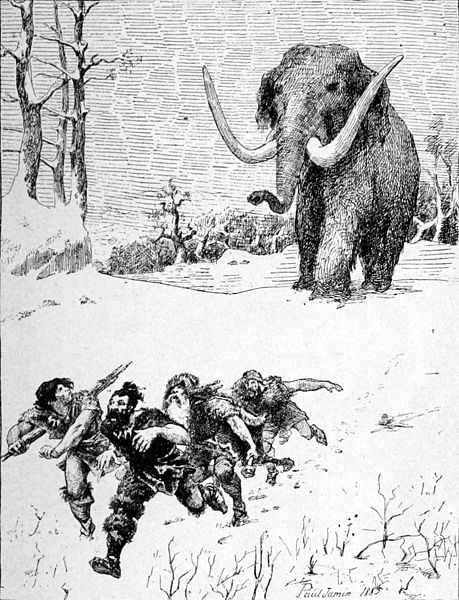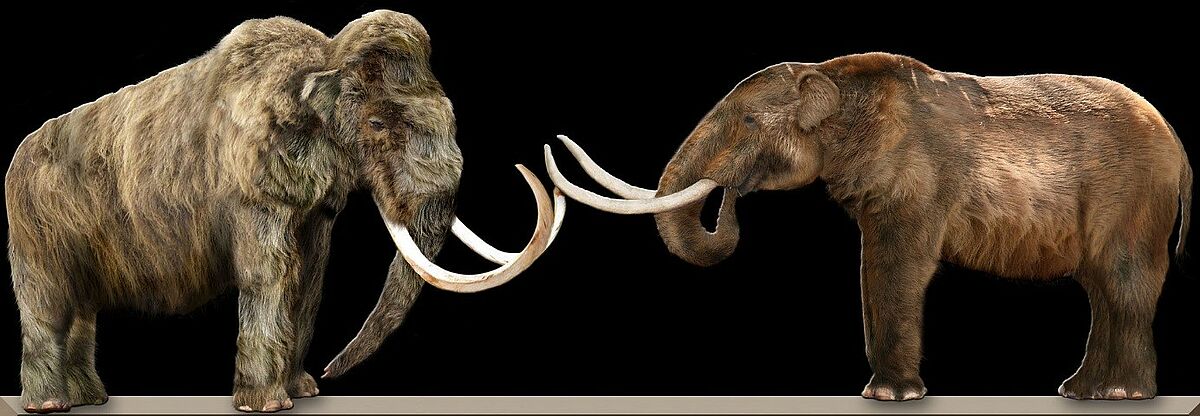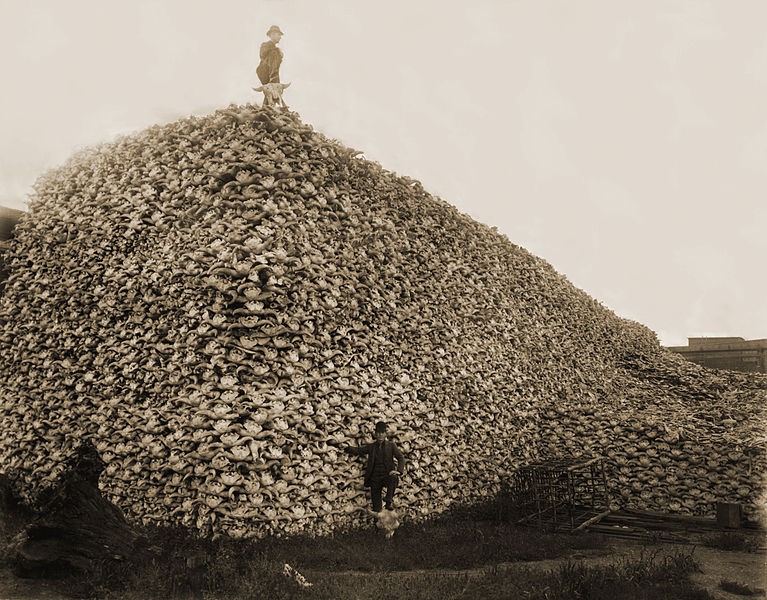Pleistocene Overkill: What Happened to the American Ice Age Megafauna?
by Stefan Krause, 04/05/2016.
Summary
At the end of the Pleistocene, roughly 11,700 years ago, climatic change coincided with the extinction of North America’s megafauna - large animals such as mastodons, saber-toothed tigers, and woolly mammoths. Historically, these events apparently coincided with the arrival of the first human beings in North America. The presumed contemporaneity inspired archaeologist Paul Martin and others in the late 1960s to propose that the Clovis people led a ‘blitzkrieg’ on North America’s megafauna. While this ‘Pleistocene overkill’ hypothesis was heavily attacked by Native American scholars and activists, its defenders became fascinated with the idea of reviving the extinct animals and suggested a “rewilding” of the Western Plains with biologically engineered versions of the Pleistocene fauna. What is the reason for the heatedness of the ongoing debate about faunicide in America? What is the evidence for a ‘Pleistocene overkill’? What are the political and ideological dimensions of the hypothesis?
Archaeologist Paul Martin popularized the hypothesis of a ‘Pleistocene overkill’ in the 1960s and refined it over the following decades. In 1967 he co-edited the book Pleistocene Extinctions: The Search for a Cause, in which he argues that humans – and not the climate change at the end of the last Ice Age – led to the extinction of great parts of Pleistocene megafauna. Anthropologists Donald K. Grayson and David J. Meltzer show that Martin’s argument goes back to 19th century hunting hypotheses from Europe (585) and is based on four premises: first, that “prehistoric human colonization of islands was followed by often massive vertebrate extinctions” (586); second, that the first humans to enter the American continent were really the people now referred to as the Clovis culture; third, that the people of the Clovis culture hunted many of the now extinct species; and fourth, that these extinctions took place in North America approximately 11,000 years ago (586). Martin bases his claims on archaeological sites which combine Clovis spear points and the remains of giant Pleistocene mammals. These sites are very rare. However, Martin takes the rarity of these sites as a support of another part of his argument: the Clovis people must have killed off the megafauna in some kind of ‘blitzkrieg’, leaving hardly a trace of the mass killing (397). In less than 1,000 years, Martin suggests, the Paleo-Indian newcomers had allegedly eliminated North America’s ancient giants.

A few others scholars followed Martin’s argument. Science writer Robert Ardrey draws similar conclusions in his book The Hunting Hypothesis (1976), and science journalist Fred Warshofsky and scientist Jared Diamond agree with Martin’s ‘blitzkrieg’ against North America’s megafauna. In Once and Future Giants (2011) science journalist Sharon Levy describes how paleoecologist Guy Robinson analyzed sediments and pollen samples in Orange County, finding that populations of large herbivores collapsed due to human impact around 14,000 years ago (5).[1] Referring to these findings, Robinson generally agrees with Martin. As a result, the widely circulated book The Sixth Extinction (2014) by the science journalist Elizabeth Kolbert treats the overkill thesis as a scientific fact (231-34). Yet, Robinson’s examinations of New York microfossils also indicate that herbivore populations had shrunk significantly long before the species died out. This, however, contradicts Martin’s assumption that the extinction took place as a ‘blitzkrieg.’ Convincing evidence for the speed and determination with which the Clovis people had allegedly hunted North America’s megafauna does not exist. In fact, as will be shown in the next section, the ‘Pleistocene overkill’ is based on many strong assumptions, supported by only minimal pieces of evidence. Thus, it is not surprising that scientists like Grayson and Meltzer have placed the scenario drawn by Martin “in the realm of faith” (585).
Criticism of the ‘Pleistocene Overkill’
Martin’s concept of a ‘Pleistocene Overkill’ leaves many questions unanswered. How did a relatively small group of hunters, using nothing but stone tools, kill entire megafauna populations? Why did the newcomers only target the largest animals and ignored average-sized game? Where are all the kill sites and weapons of this hunting spree? The questions illustrate that slender archaeological evidence and logical gaps make it difficult to accept ‘Pleistocene overkill’ as a scientific theory. When large populations of giant animals throughout a vast continent are killed by hunters with primitive tools, we should expect these hunters to have come in big groups. If we accept that there was a huge number of hunters involved, we have to expect a corresponding body of evidence for the presence of these hunters, their tools, and their killing sites. But as Grayson and Meltzer conclude, after having analyzed 76 sites related to the possible overkill events, “only 14 provide strong evidence that Clovis-aged people hunted such mammals. Of these sites, 12 contain the remains of mammoth, while two contain the remains of mastodon” (quoted in Mackenthun, “Night of First Ages”).
Kill sites of other megafauna species which went extinct around the same time are missing. For a bold claim as that of a ‘blitzkrieg’ overkill this evidence is rather slim.
Next to Grayson and Meltzer, the Native American writer Vine Deloria, Jr. is probably the harshest critic of the ‘Pleistocene overkill’ hypothesis. In his book Red Earth, White Lies (1997) he criticizes – at times very polemically – the scholarly practices of the colonial sciences archaeology, paleontology, and anthropology and argues that the scenario of a ‘Pleistocene overkill’ lacks any convincing evidence, merely making Native Americans and their ancestors the scapegoat for the extinctions (97). Deloria passionately counter-argues Martin’s claim and raises the question as to why the overkill scenario did not spare megacarnivores, while “smaller-sized animals, which would have been easier to kill” were not affected by the Paleo-Indian hunting rage (103). In another chapter, Deloria responds to Jared Diamond’s calculations of the population size necessary to account for the hunting ‘blitzkrieg’. Referring to the lack of evidence on which the ‘Pleistocene overkill’ hypothesis is based, Deloria jokes that the population of 10 million Paleo-Indians, as Diamond has calculated, “should have left a little graffiti and picnic litter somewhere” (145).
The Search Goes on: How Did the Pleistocene Megafauna Die?
There is a large number of alternative explanations for the collapse of the Pleistocene megafauna. In most cases, these explanations leave a few questions open. For example, zoologist Norman Owen-Smith has argued that neither climate change nor human predation provide a sufficient explanation for the Pleistocene extinctions. The changing climate “fails to predict the increased likelihood of extinctions with increasing body size, greater severity in both North and South America than in Eurasia or Australia, lack of simultaneous extinctions in Africa and tropical Asia, and the absence of extinctions at the end of previous glacial periods,” whereas the overkill hypothesis “fails to explain the simultaneous extinctions of a number of mammalian and avian species not obviously vulnerable to human overkill” (351). Instead Owen-Smith emphasizes the important role of large herbivores and how a decrease in their populations could cause the regional flora and fauna to change, which eventually results in the extinction of some, but not all species.[2] With regard to American herbivores this scenario seems possible, but the culprits would be the same and the problem of sparse evidence remains.
In a similar way, many recent theories try to establish a compromise between focusing on extensive human predation and entirely dismissing the impact of hunters. For instance, a team of scientists around ethnobiologist Steve Wolverton (2009) argued that an increase in biomass production and seasonal change may have made large herbivores particularly vulnerable to extinction, and concluded that these two factors “appear to have worked in tandem to contribute significantly to, if not simply cause, the late Pleistocene extinctions” (56). At the same time, Wolverton and his colleagues do not exclude the possible influence of human predation. Final conclusions about the fate of the Pleistocene giants have not yet been reached, and there is an unabated fascination with mammoths and mastodons.
The Pleistocene Debate: Why Does It Matter?
Discussions about the fate of the Pleistocene megafauna are politically and ecologically relevant. Questions of who or what shaped North America’s distant past have an impact on the rights and identities of Native Americans today. Searching for who killed off America’s once imposing megafauna, some scholars have no problem to name the ancestors of Native Americans as the prime suspects. Yet when the identity of prestigious finds such as that of ‘Kennewick Man’ (link to article) is in question, many American scientists dismissed the possibility of a connection to America’s present indigenous people and related the skeleton to ancient Asian populations. These ‘findings’ apparently still follow the need to justify America’s colonial history and the removal of Native Americans during the colonial period and the ecologically at times disastrous settlement of the American continent. The overkill hypothesis, presented as accepted wisdom in popular scientific discourse, combines a strong mythical narrative of indigenous savagism with a remarkable lack of sufficient scientific evidence. Scholars like Shepard Krech III extend the overkill thesis into much more recent times and hold Native Americans responsible for the more recent destruction of America’s charismatic fauna, basing their claim on the indigenous people’s unfamiliarity with Western concepts and strategies of conservation and ecology. This Eurocentric rhetoric, criticized by several authors, gave rise to the “myth of the un-ecological Indian” (Mackenthun, “Bisoncide”).
It is somewhat bizarre how the impact of one story (i.e. the ‘Pleistocene overkill’) helped to create a veritable myth. This myth has specific political implications: if the indigenous people of America have behaved and still behave in an ‘unecological’ manner, their claims to special hunting or fishing rights may easily dwindle. In the age of conservationism this reasoning can be quite influential. It supports the Western perspective that hunting and gathering are not only uneconomical, but actually dangerous for the environment. This view, however, ignores that ‘hunter-gatherer’ land use did not work within the capitalistic framework of profit and wealth. ’Hunter-gatherers’ on both sides of the Atlantic Ocean had different concepts of ‘wealth’ in pre-capitalist times. On the American side, more emphasis was placed on sustainability while in feudalist Europe the aristocracy insisted on its prerogative to hunt.[3] The myth of the Indian as savage hunter of megafauna also diverts attention from the fact that the impact of a capitalistic, modern world was and is environmentally by far more devastating. The extant Bison bison, for example, had almost been exterminated by European-American settlers in the 19th century.
Human agency evidently shaped the collapse and later recovery of American bison populations. With regard to the Pleistocene extinctions, verifiable human impact is limited to popular and scientific discourse and storytelling, which aims at constructing a desired past.
NOTES
[1] Robinson analyzes the distribution of Sporormiella, a fungus found in herbivore dung. The extinction of large herbivores led to the disappearance of Sporormiella. Therefore, the time and speed of extinction of ice age herbivores can be calculated.
[2] He uses examples from other regions of the world and recent megaherbivores such as the African elephant to underline the impact of these animals on the local vegetation. Grazing megaherbivores like elephants and rhinoceroses transform forests into grasslands, and an “elimination of megaherbivores elsewhere in the world by human hunters at the end of the Pleistocene would have promoted reverse changes in vegetation” (351) which eventually would have had a negative impact on smaller herbivores.
[3] For example, in her 1995 essay “Do Rocks Listen?” Elizabeth Povinelli examines how aboriginal Australians are capable of cultivating land in a sustainable and ecological fashion without applying Western economic concepts.
WORKS CITED
Deloria Jr., Vine. Red Earth – White Lies. Native Americans and the Myth of Scientific Fact. Golden, CO: Fulcrum, 1997.
Grayson, Donald K., and David Meltzer. “A Requiem for North American Overkill.” Journal of Archaeological Science 30 (2003) 285-93.
Kolbert, Elizabeth. The Sixth Extinction. An Unnatural History. London: Bloomsbury. 2014.
Levy, Sharon. Once & Future Giants: What Ice Age Extinctions Tell Us about the Fate of Earth's Largest Animals. Oxford: Oxford University Press, 2011.
Mackenthun, Gesa. “Bisoncide and Neo-Savagism: The Myth of the Unecological Indian.” America After Nature. Ed. Catrin Gersdorf et al. Heidelberg: Winter, 2016. In print.
Mackenthun, Gesa. “Night of First Ages: Colonial Chronologies and Painful Transculturation.” Crossroads in American Studies: Transnational and Biocultural Encounters. Eds. Frederike Offizier, Marc Priewe, Ariane Schröder. Heidelberg: Winter, 2016. In print.
Martin, Paul S. “Prehistoric Overkill.” Pleistocene Extinctions. Ed. Paul S. Martin and H.E. Wright. New Haven, CT: Yale University Press, 1967. 75-120.
Owen-Smith, Norman. “Pleistocene Extinctions: The Pivotal Role of Megaherbivores”. Paleobiology 13.3 (1987): 351–362.
Povinelli, Elizabeth A. “Do Rocks Listen? The Cultural Politics of Apprehending Australian Aboriginal Labor”. American Anthropologist 97.3 (1995): 505–518.
Wolverton, Steve, et al. “The Terminal Pleistocene Extinctions in North America, Hypermorphic Evolution, and the Dynamic Equilibrium Model.” Journal of Ethnobiology 29.1 (2009): 28–63.
FURTHER READING
Meltzer, David J. First Peoples in a New World: Colonizing Ice Age America. Berkeley: University of California Press, 2009.
Meltzer, David. The Great Paleolithic War. How Science Forged an Understanding of America’s Ice Age Past. University of Chicago Press, 2015.
ILLUSTRATIONS
Figure 1: Source: Paul Jamin [Public domain], via Wikimedia Commons. {{PD-old-100}} {{PD-1923}}.
Figure 2: Source: Dantheman9758. MammothVsMastodon. 2007. Wikimedia Commons. Wikimedia Foundation. Web. 5 April 2016. <https://commons.wikimedia.org/wiki/File:MammothVsMastodon.jpg.>
Figure 3: Source: Unknown. Bison skull pile-restored. 1870. Wikimedia Commons. Wikimedia Foundation. Web. 5 April 2016. <https://commons.wikimedia.org/wiki/File:Bison_skull_pile-restored.jpg.>


